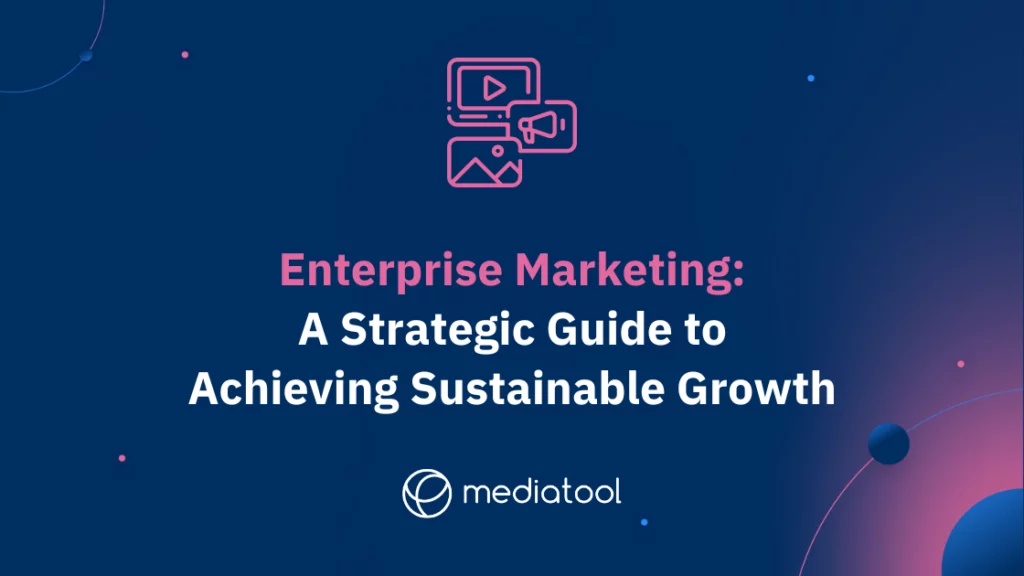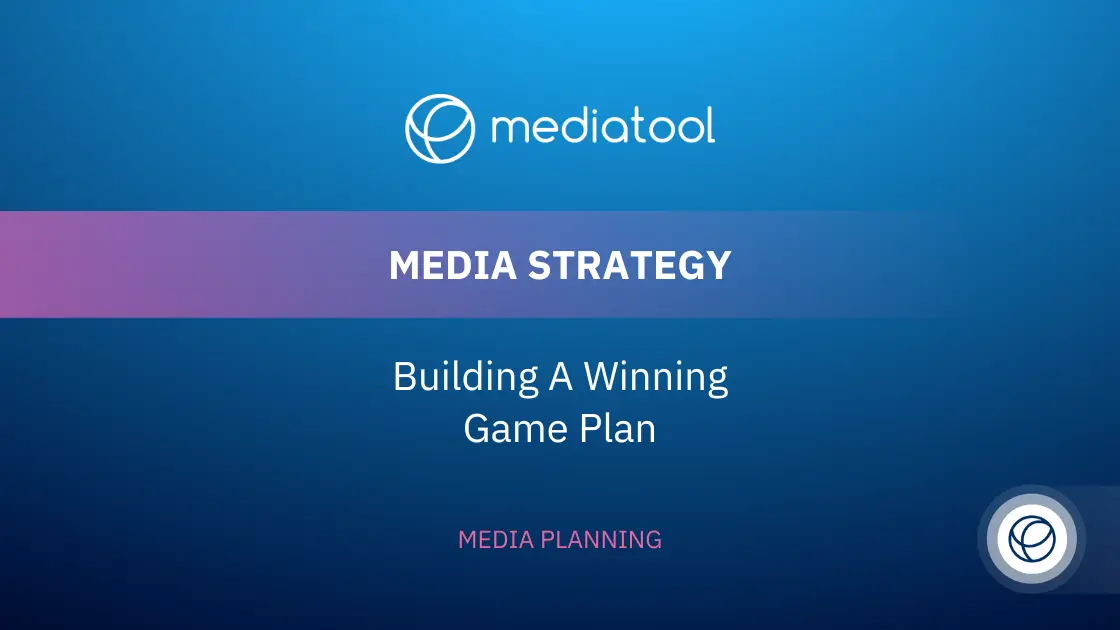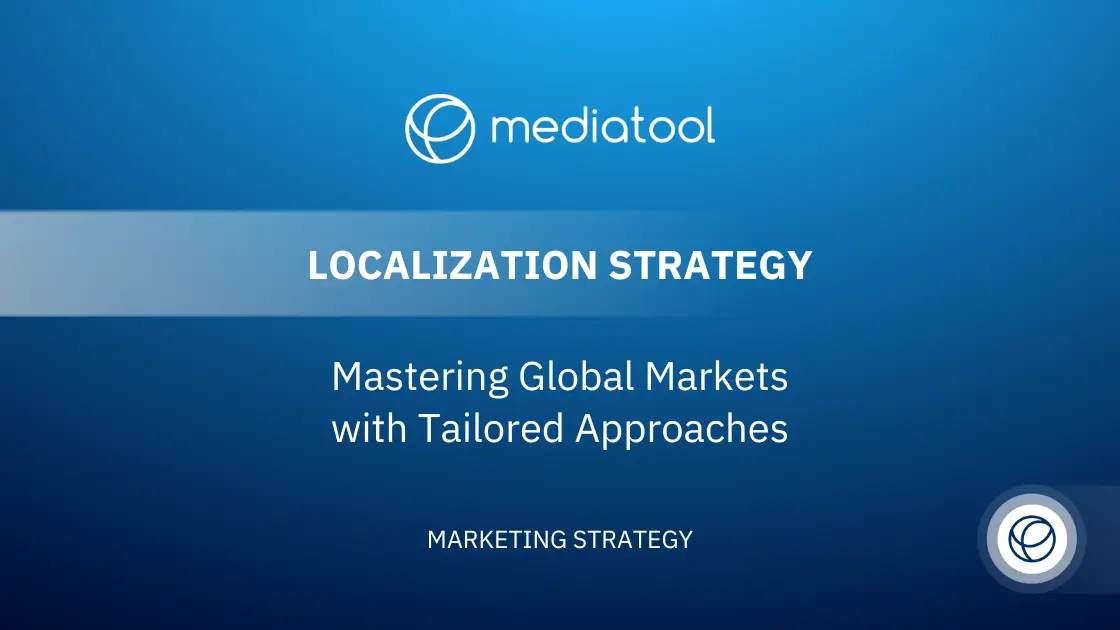Enterprise marketing is a key driver of sustainable growth for big brands. It’s a multifaceted approach that requires strategic thinking and a deep understanding of the market and target audience.
In this guide, we’ll delve into the various ways top companies leverage enterprise marketing to drive long-term success.
We’ll explore the tactics that the most prominent brands use to stay ahead of the competition and achieve consistent growth year after year.
If you’re ready to learn more about how big brands are achieving sustainable growth through enterprise marketing, keep reading!
What is Enterprise Marketing?
Enterprise marketing is a sophisticated approach adopted by large-scale businesses to expand and maintain their customer base. It involves integrating growth-oriented enterprise marketing strategies with resources from various departments, emphasizing a cohesive marketing effort.
Characteristics of Enterprise-Level Businesses
Typically, an enterprise-level business, with annual revenues nearing one billion dollars and over 1,000 employees, employs enterprise marketing management to navigate the complexities of large-scale operations. This approach includes multiple channels and tactics, far surpassing the scope of typical marketing programs.
Tools for an Enterprise Marketing Strategy
Enterprise companies leverage their size and reputation for enhanced brand recognition and customer base growth. They utilize a range of enterprise marketing tools, including marketing automation, content management systems, and enterprise marketing software. These tools aid in executing sophisticated marketing campaigns, managing customer relationship and content management system (CRM) processes, and understanding customer lifetime value.
Personalized Marketing and Brand Consistency
These companies also adopt account-based marketing (ABM) and focus on tailoring their digital marketing efforts to specific segments of their target audience. This personalized approach is supported by comprehensive customer data and analytics, allowing for tailored marketing strategies and campaigns.
Enterprise marketing programs also emphasize the importance of a consistent brand voice across all marketing channels, from social media posts to email marketing. The company’s internal marketing team, often led by a chief marketing officer, works to ensure that all marketing tactics align with the company’s overall marketing goals and target market.
What are the Challenges with Enterprise Marketing?
Complexity and Resource Intensity
Enterprise marketing encompasses a range of challenges, each demanding strategic focus and resources to ensure a successful enterprise marketing strategy. These challenges are more intricate and resource-heavy for enterprise companies compared to small and medium-sized businesses (SMBs).
Key challenges in enterprise marketing include:
- Gaining a deep understanding of the target audience
- Handling a substantial volume of customer data
- Aligning marketing efforts with overarching business goals
- Keeping pace with rapid technological advancements
- Accurately measuring marketing return on investment (ROI)
- Forming and sustaining efficient marketing teams
- Effective management of marketing budgets
- Enhancing brand awareness and cultivating customer loyalty
- Personalizing marketing strategies for potential customers
- Navigating risk aversion and bureaucratic hurdles
- Creating consistent, compelling content
- Implementing precise measurement, analytics, and attribution methods
- Managing and incorporating customer feedback
- Adhering to regulatory, compliance, and privacy requirements
In the report “Enterprise Content Marketing: Benchmarks, Budgets, and Trends – Insights for 2023,” a significant majority of enterprise content marketers, amounting to 64%, have identified communication among internal teams and silos as a major challenge.
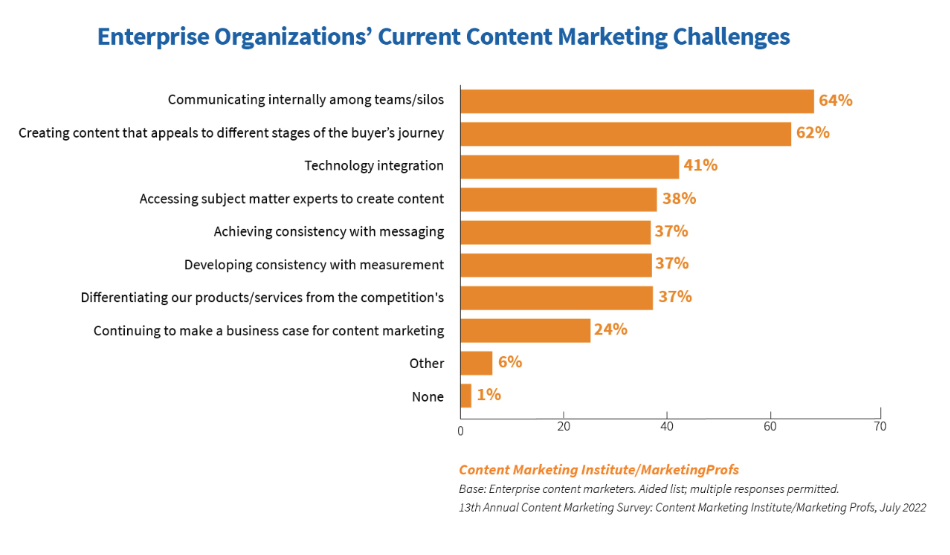
Source: Content Marketing Institute
Strategies for Overcoming Challenges
To navigate these challenges, the enterprise marketing manager and marketers should prioritize key areas such as understanding the target audience, aligning marketing campaigns with business objectives, prudent budget management, developing impactful content, and maintaining compliance with regulations and customer privacy. These focal points are crucial for the success of enterprise marketing campaigns and demand significant attention and resources.
Incorporating enterprise marketing tools and software, leveraging customer relationship management (CRM) systems, and deploying multi-channel marketing strategies, including social media marketing and email marketing, are instrumental. Sales and marketing teams, guided by a marketing manager or chief marketing officer, should work collaboratively to ensure a cohesive marketing program and consistent brand voice across all marketing channels.
This strategic approach, emphasizing effective enterprise marketing strategies and management, is essential for enterprise companies to overcome the unique challenges they face and achieve their enterprise marketing goals.
13 B2B Enterprise Marketing Strategies
Here are a few strategic ways that top companies leverage enterprise marketing to drive long-term success:
1. Reduce Friction and Create Simplified, Self-serve Experiences
Streamlining the Customer Journey
It’s crucial to streamline the customer journey, making high-investment enterprise-grade products more accessible. Friction in the buying process, manifesting as inadequate information, complex purchase procedures, or diminished brand trust, can deter potential customers.
In a survey conducted in 2023, nearly half (49%) of enterprise marketers identified establishing a unified source for tracking customer journey touchpoints as one of their top five priorities in digital advertising.
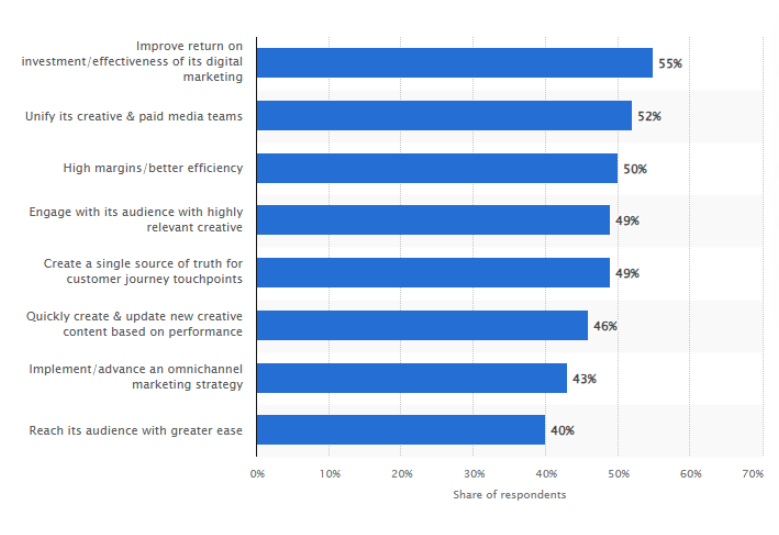
Source: Statista
Mitigating Barriers with Strategic Initiatives
To mitigate these barriers, businesses should employ strategies like offering free trials and simplifying the purchasing process. These steps not only reduce friction but also enhance customer relationship management (CRM). Transparent pricing, detailed product information, and an efficient purchasing process are essential components of this strategy. User-friendly products lead to customer satisfaction, which in turn can amplify growth, revenue, brand recognition, and customer base expansion.
Adapting to Post-Pandemic Preferences
With a significant shift towards self-service experiences post-pandemic, with 30% of customers preferring remote interactions or self-service options, enterprises must integrate these preferences into their marketing strategies. This adaptation is vital for effective enterprise marketing management.
Utilizing Tools for Streamlined Processes
Utilizing enterprise marketing tools and software, such as marketing automation and content management systems, can further streamline these processes. The enterprise marketing team, including the chief marketing officer and marketing managers, should focus on aligning these streamlined processes with the overall enterprise marketing strategy and campaigns.
Creating Simplified, Self-Serve Experiences
Creating a simplified, self-serve customer experience is a key marketing tactic for enterprise businesses. This approach, part of a broader multi-channel marketing strategy, is critical for addressing the specific needs of the target market, building brand awareness, and ensuring a consistent brand voice across all marketing channels. Such strategic efforts by enterprise marketing teams are essential for achieving enterprise marketing goals and fostering long-term relationships with enterprise customers.
2. Start Tracking Joint Marketing + Sales Metrics That Matter Most
Traditionally, enterprise marketing departments and sales teams have relied on marketing qualified leads (MQLs) to measure success, incentivizing overinvestment in low-value activities. However, with the rise of data-driven marketing, companies are shifting towards “conversation readiness,” using customer interaction data to evaluate intent and prioritize efforts towards high-quality leads that are more likely to convert. This approach results in more efficient use of resources and improved collaboration between sales and marketing teams, leading to better targeting and a higher likelihood of closing deals.
3. Understand that Customers are Demanding Expertise Above All Else
Enterprise-level businesses must demonstrate expertise to meet customers’ increasing demand for knowledge and guidance in making informed decisions. They can achieve this by positioning themselves as thought leaders through educational content. By developing and sharing authentic, high-quality, informative, and educational content, businesses can establish themselves as experts and gain the trust of potential customers. This can include blog posts, e-books, white papers, webinars, and more, to create a diverse set of content that caters to different audiences and their needs.
Another approach is offering free trials and consultations, providing transparent information, and delivering excellent customer service and technical support through various channels. This will build trust and credibility, leading to a loyal customer base.
4. Deploy Omnichannel Strategies that Convert More
Omnichannel sales models are more successful compared to traditional models that rely on one channel alone.
Customers want more channels, convenience, and a more personalized experience. If they don’t get what they’re looking for, they’re more willing than ever to switch suppliers. More, in fact, is better.
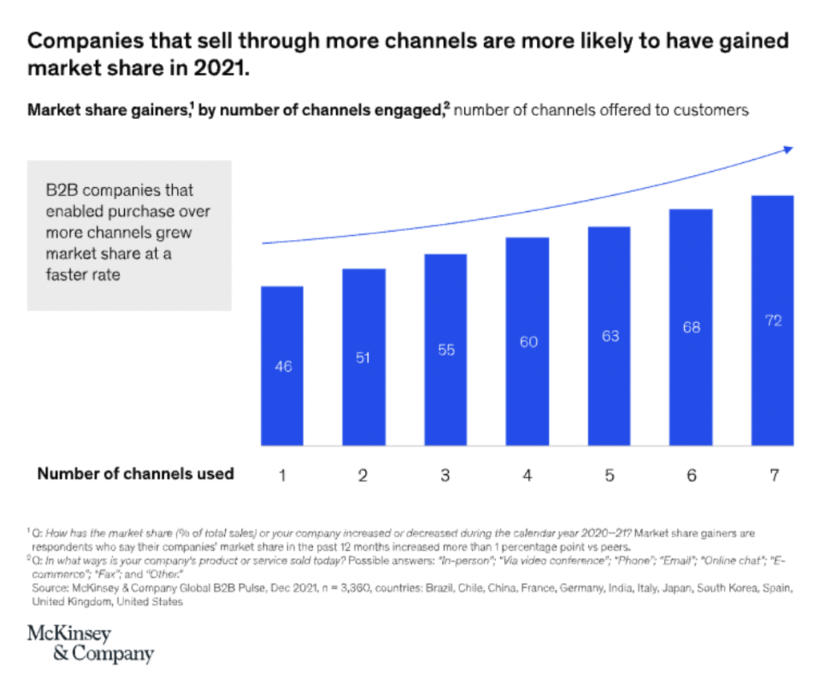
Enterprise-level companies often have more resources for executing impactful marketing campaigns and, thus, may operate across more channels. However, managing and optimizing the performance of each channel can be difficult, especially when allocating resources accordingly.
It’s important to have a solid strategy and ensure you’re getting the best possible results from all your channels. Still, it can be challenging when you have limited resources or multiple campaigns trying to run simultaneously.
5. Focus on Marketing-Influenced Pipeline and Revenue
In enterprise marketing, companies need to understand the impact of their marketing activities on the bottom line. One way to do this is by focusing on metrics that measure the influence of marketing on the sales pipeline and revenue.
This includes the marketing-influenced pipeline (MIP), which measures the number of potential deals in the sales pipeline that can be attributed to marketing efforts, and marketing-influenced revenue (MIR), which measures the revenue generated by deals that can be attributed to marketing efforts.
By focusing on these metrics, companies can better understand the impact of their marketing efforts on the bottom line, optimize their marketing strategies, align marketing and sales efforts, and improve the customer journey.
6. Invest Wisely in Your Marketing Strategies
Companies should focus on investing in strategies leading to long-term success instead of solely focusing on short-term gains. Cost-cutting measures during economic uncertainty can negatively impact the business and take years to undo. To maintain long-term growth, it’s important to protect expenses related to branding and relationships with customers, employees, and partners. B2B CMOs should resist short-term thinking and invest for long-term success.
Investing in a consistent and ongoing content marketing strategy is essential for building an audience and establishing a company as a thought leader in its industry. This will help attract new customers and keep current customers engaged, providing long-term benefits to the company.
Employee experience (EX) is just as necessary as customer experience (CX) when it comes to ensuring the success of a business. A survey by Forrester shows that 90% of B2B organizations consider improving CX to be a top priority in the next year. By encouraging leadership to invest in employee experience and engage employees in the same way as customers, B2B CMOs can show the impact of EX on the bottom line and share the cost and responsibility with others.
7. Develop Post-sale Customer Engagement
B2B companies should prioritize post-sale customer engagement to retain customers, increase sales to existing accounts, build brand awareness and create positive word-of-mouth. Many high-growth enterprises recognize this, and 34% of marketing leaders with decision-making power over customer engagement plan to increase their budget for this area by at least 10%.
8. Build a Robust and Purpose-driven Brand
A brand purpose is a statement of how a company aims to make the world a better place, and this is becoming increasingly important as society holds brands to higher standards. Corporate social responsibility (CSR) is now a crucial function impacting the company. When making decisions, customers and buyers consider environmental, social, and governance (ESG) factors; top talent seeks out companies that align with their values. Investors are more likely to invest in companies that prioritize these issues.
Even when deploying technology, ethics will take a key seat in strategic decisions. For example, according to Gartner, 70% of enterprise CMOs will identify accountability for ethical AI in marketing as one of their top concerns.
Similarly, crafting a brand that truly resonates with customers can be the difference between them choosing your company over the competition. Developing a solid brand that is easy to recognize and remember can create trust, establish credibility, and ultimately lead to increased customer loyalty and long-term success.
9. Leverage Data and Analytics
Data and analytics are critical tools for enterprises in today’s competitive landscape. By collecting and analyzing data, enterprises can gain a deep understanding of their customers and the market they operate in. This information can inform and guide marketing decisions, leading to more effective and efficient marketing strategies.
Enterprises can leverage data in several ways to drive their marketing strategies. For example, they can use data to identify target audiences, determine the most effective channels for reaching those audiences, and track the performance of their marketing campaigns. This information can be used to optimize campaigns, reduce waste, and increase the ROI of marketing efforts.
Additionally, data can be used to better understand existing customer base’ behavior and preferences. By tracking their online and offline behaviors, enterprises can gain valuable insights into what motivates customers to make purchases, their pain points, and their preferences regarding product features and benefits.
10. Develop a Customer-centric Approach
Companies need to adopt a customer-centric approach. This means placing the customer at the center of all business decisions, from product development to marketing and customer service. By doing so, companies can create a competitive advantage and increase customer loyalty, ultimately driving growth and success.
One of the key benefits of a customer-centric approach is that it helps companies understand their customer’s unique needs and challenges. By collecting and analyzing customer data, companies can gain valuable insights into what motivates their customers, their pain points, and what they’re looking for in a product or service. This information can then be used to create more personalized and effective marketing campaigns, leading to improved customer engagement and increased sales.
In addition, a customer-centric approach can also lead to increased customer loyalty and advocacy. When customers feel that a company truly cares about their needs and is committed to delivering value, they’re more likely to become repeat customers and recommend the company to others. This can drive organic growth and help the company build a strong reputation in the market.
11. Build a Multi-channel Marketing Strategy
With many channels available to reach customers, it’s essential to utilize a variety of them to maximize your reach and increase the chances of converting leads into customers.
A multi-channel marketing strategy involves using a combination of different channels to reach and engage with customers. This might include email, social media, paid advertising, and more.
One of the key benefits of a multi-channel marketing strategy is that it allows businesses to reach customers where they’re most active. For example, some customers may be more active on social media, while others may prefer email. By using a variety of channels, businesses can ensure that they’re reaching customers where they’re most likely to engage with their brand.
According to US B2B Marketers, here are the top marketing channels that have the most impact on multi-marketing strategy:
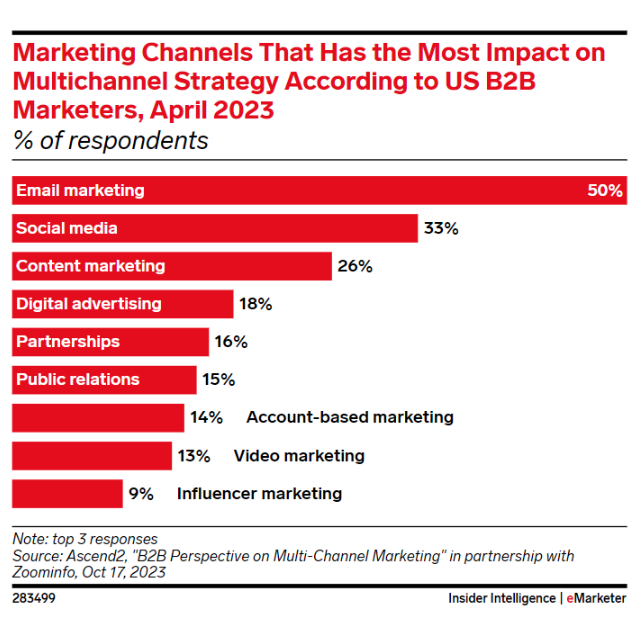
Source: Insider Intelligence
12. Create a Strong Value Proposition
A value proposition is a statement that communicates what makes a company unique, what value it can bring to customers, and how it can solve their problems.
A strong value proposition is crucial for setting a company apart from its competitors and increasing the chances of converting leads into customers. By clearly articulating what makes a company unique, customers can understand why they should choose that company over others. This can lead to increased brand awareness and ultimately drive more sales.
One of the key benefits of a strong value proposition is that it helps companies focus on what they do best. By clearly articulating what they offer and why it’s unique, companies can prioritize their efforts and resources, leading to more effective and efficient marketing campaigns.
Another benefit of a strong value proposition is that it can help companies differentiate themselves from their competitors. It can be difficult for customers to choose one company over another in a crowded market. By clearly communicating what makes a company unique, businesses can make it easier for customers to make an informed decision and ultimately choose them over their competitors.
13. Continuously Test and Refine Your Marketing Strategies
The marketing world is constantly changing. What worked yesterday may not work today. After planning your marketing strategy, regularly testing and refining marketing strategies based on data and customer feedback can help companies stay ahead of the game and optimize marketing efforts for long-term success. With continuous optimization, businesses can identify the most effective tactics, stay agile and improve their ROI.
Remember that these marketing strategies employed above should be tailored and tested to your specific target audience and industry.
Enterprise Marketing Software
One of the tough challenges of enterprise marketing is ensuring all the tech you use can work together smoothly to handle all the complex processes across the whole organization.
With the rise of digital technologies and the increasing complexity of modern marketing, businesses need to manage and automate their marketing efforts to succeed effectively.
Enterprise marketing software provides companies with the tools and technologies they need to streamline their marketing processes, improve efficiency, and drive better results. From automating routine tasks and tracking performance to analyzing customer data and optimizing campaigns, enterprise marketing software can help companies improve their marketing efforts and achieve their goals.
When it comes to enterprise marketing, there are a ton of different software options out there that can help with different aspects of the process. Here are some of the most common types:
- CRM software
- Marketing Automation software
- Analytics software
- Advertising software
- Email marketing software
- Social media management software
- Account-based marketing (ABM) software
- Media planning and buying software
- Budgeting and forecasting software
- Business Intelligence (BI) software
- Project management tools
- Chatbot software
These are just a few examples. What works best will depend on your company’s specific goals, audience, and resources.
What’s Next?
When it comes to enterprise marketing, the stakes are high for big brands. These companies have a lot riding on their marketing efforts, as they need to drive long-term success to stay competitive and maintain profitability.
Companies can create effective marketing strategies that drive growth and profitability by building strong customer relationships, creating a consistent brand image, and leveraging the latest technology and data.
By taking a holistic approach to their marketing campaign and focusing on both short-term and long-term goals, big brands can set themselves up for long-term success and maintain a competitive advantage in their respective industries.
Looking to take your enterprise marketing efforts to the next level? Take a tour of Mediatool today.
